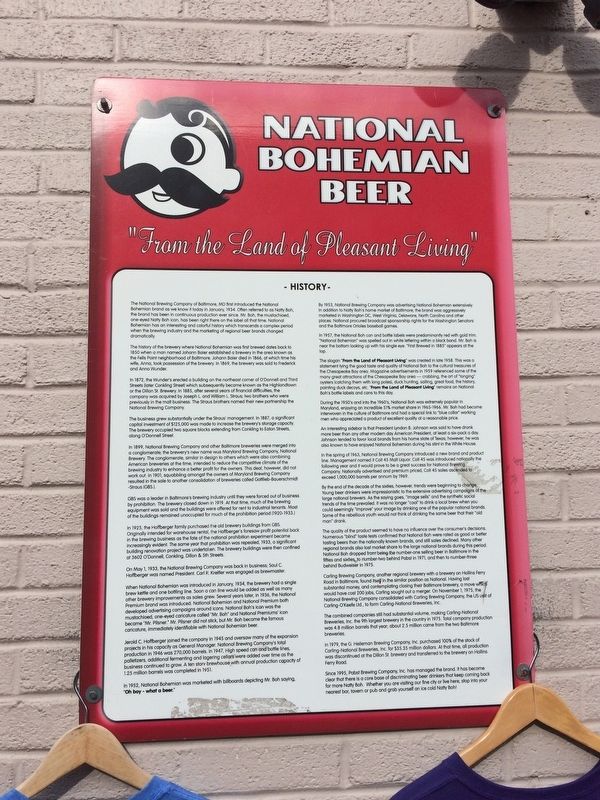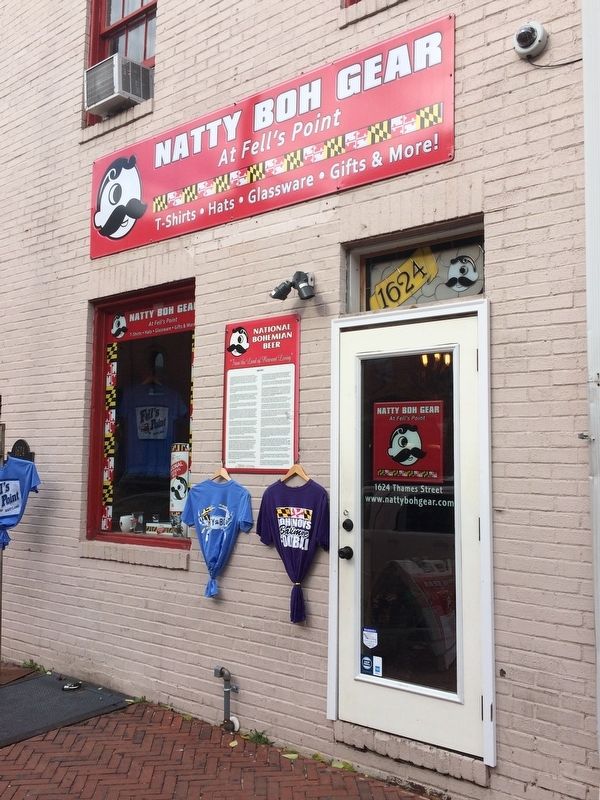Fells Point in Baltimore, Maryland — The American Northeast (Mid-Atlantic)
National Bohemian Beer
"From the Land of Pleasant Living"
— History —
The National Brewing Company of Baltimore, MD first introduced the National Bohemian brand as we know it today in January, 1934. Often referred to as Natty Boh, the brand has been in continuous production ever since. Mr. Boh, the mustachioed, one-eyed Natty Boh icon, has been right there on the label all that time. National Bohemian has been an interesting and colorful history which transcends a complex period when the brewing industry and the marketing of regional beer brands changed dramatically.
The history of the brewery where National Bohemian was first brewed dates back to 1850 when a man named Johann Baier established a brewery in the area known as the Fells Point neighborhood of Baltimore. Johann Baier died in 1866, at which time his wife, Anna, took possession of the brewery. In 1869, the brewery was sold to Frederick and Anna Wunder.
In 1872, the Wunder's erected a building on the northeast corner of O'Donnell and Third Streets (later Conkling Street) which subsequently became known as the Highlandtown or the Dillon St. Brewery. In 1885, after several years of financial difficulties, the company was acquired by Joseph L. and William L. Straus; two brothers who were previously in the malt business. The Straus brothers named their new partnership the National Brewing Company.
The business grew substantially under the Straus' management. In 1887, a significant capital investment of $125,000 was made to increase the brewery's storage capacity. The brewery occupied two square blocks extending from Conkling to Eaton Streets, along O'Donnell Street.
In 1899, National Brewing Company and other Baltimore breweries were merged into a conglomerate; the brewery's new name was Maryland Brewing Company, National Brewery. The conglomerate, similar in design to others which were also combining American breweries at the time, intended to reduce the competitive climate of the brewing industry to enhance a better profit for the owners. This deal, however did not work out. In 1901, squabbling amongst the owners of Maryland Brewing Company resulted in the sale to another consolidation of breweries called Gottlieb-Bauerschmidt-Straus (GBS.).
GBS was a leader in Baltimore's brewing industry until they were forced out of business by prohibition. The brewery closed down in 1919. At that time, much of the brewing equipment was sold and the buildings were offered for rent to industrial tenants. Most of the buildings remained unoccupied for much of the prohibition period (1920-1933.)
In 1925, the Hoffberger family purchased the old brewery buildings from GBS. Originally intended for warehouse rental, the Hoffberger's foresaw profit potential back in the brewing
On May 1, 1933, the National Brewing Company was back in business; Saul C. Hoffberger was named President. Carl R. Kreitler was engaged as brewmaster.
When National Bohemian was introduced in January, 1934, the brewery had a single brew kettle and one bottling line. Soon a can line would be added as well as many other brewery improvements as sales grew. Several years later, in 1936, the National Premium brand was introduced. National Bohemian and National Premium both developed advertising campaigns around icons. National Boh's icon was the mustachioed, one-eyed caricature called "Mr. Boh" and National Premium's icon became "Mr. Pilsner." Mr. Pilsner did not stick, but Mr. Boh became the famous caricature, immediately identifiable with National Bohemian beer.
Jerold C. Hoffberger joined the company in 1945 and oversaw many of the expansion projects in his capacity as General Manager. National Brewing Company's total production in 1946 was 270,000 barrels. In 1947, High speed can and bottle lines, palletizers, additional fermenting and lagering cellars were added over time as the business continued to grow. A ten story brewhouse with annual production capacity of 1.25 million barrels was completed in 1951.
In 1952, National Bohemian was marketed with billboards depicted Mr. Boh saying, "Oh boy - what a beer."
By 1953, National Brewing Company was advertising National Bohemian extensively. In addition to Natty Boh's home market of Baltimore, the brand was aggressively marketed in Washington DC, West Virginia, Delaware, North Carolina and other places. National procured broadcast sponsorship rights for the Washington Senators and the Baltimore Orioles baseball games.
In 1957, the National Boh can and bottle labels were predominantly red with gold trim. "National Bohemian" was spelled out in white lettering within a black band. Mr. Boh is near the bottom looking up with his single eye. "First Brewed in 1885" appears at the top.
The slogan "From the Land of Pleasant Living" was created in late 1958. This was a statement tying the good taste and quality of National Boh to the cultural treasures of the Chesapeake Bay area. Magazine advertisements in 1959 referenced some of the many great attractions of the Chesapeake Bay area --- crabbing, the art of "tonging" oysters (catching them with long poles), duck hunting, sailing, great food, the history, painting duck decoys, etc. "From the Land of Pleasant Living" remains on National Boh's bottle labels and cans to this day.
During the 1950's and into the 1960's, National Boh was extremely popular in MAryland, enjoying an incredible 51% market share in 1965-1966. Mr. Boh had become interwoven in the culture of Baltimore and had a special link to "blue collar" working men who appreciated a product of excellent quality at a reasonable price.
An interesting sidebar is that President Lyndon B. Johnson was said to have drank more beer than any other modern day American President, at least a six-pack a day. Johnson tended to favor local brands from his home state of Texas; however, he was also known to have enjoyed National Bohemian during his stint in the White House.
In the spring of 1963, National Brewing Company introduced a new brand and product line. Management named it Colt 45 Malt Liquor. Colt 45 was introduced nationally the following year and it would prove to be a great success for National Brewing Company. Nationally advertised and premium priced, Colt 45 sales ascended to exceed 1,000,000 barrels per annum by 1969.
By the end of the decade of the sixties, however, trends were beginning to change. Young beer drinkers were impressionistic to the extensive advertising campaigns of the large national brewers. As the saying goes, "image sells" and the synthetic social trends of the time prevailed. It was no longer "cool" to drink a local brew when you could seemingly "improve" your image by drinking one of the popular national brands. Some of the rebellious youth would not think of drinking the same beer that their "old man" drank.
The quality of the product seemed to have no influence over the consumer's decisions. Numerous "blind" taste tests confirmed that National Boh were rated as good or better tasting beers than the nationally known brands, and still sales declined. Many other regional brands also lost market share to the large national brands during this period. National Boh dropped from being the number-one selling beer in Baltimore in the fifties and sixties, to number-two behind Pabst in 1971, and then to number-three behind Budweiser in 1975.
Carl Brewing Comapny, antoher regional brewery with a brewery on Hollins Ferry Road in Baltimore, found itself in the similar position as National. Having lost substantial money, and contemplating closing their Baltimore brewery, a move which would have cost 200 jobs, Carling sought out a merger. On November 1, 1975, the National Brewing Company consolidated with Carling Brewing Company, the US unit of Carling-O'Keefe Ltd., to form Carling-National Breweries, Inc.
The combined companies still had substantial volume, making Carling-National Breweries, INc. the 9th largest brewery in the country in 1975. Total company production was 4.8 million barrels that year; about 2.5 million came from the two Baltimore breweries.
In 1979, the G. Hellerman Brewing Comapny, Inc. purchased 100% of the stock of Carling-National Breweries, Inc. for $35.35 million dollars. At that time, all production was discontinued at the Dillon St. brewery and transferred to the brewery on Hollins Ferry Road.
Since 1995, Pabst Brewing Company, Inc. has managed the brand. It has become clear that there is a core base of discriminating beer drinkers that keep coming back for more Natty Boh. Whether you are visiting our fine city or live here, stop into your nearest bar, tavern or pub and grab yourself an ice cold Natty Boh!
Topics. This historical marker is listed in this topic list: Industry & Commerce. A significant historical year for this entry is 1850.
Location. Marker has been permanently removed. It was located near 39° 16.888′ N, 76° 35.653′ W. Marker was in Baltimore, Maryland. It was in Fells Point. Marker was on Thames Street west of South Broadway. On the side of Natty Boh Gear on Thames Street. Touch for map. Marker was at or near this postal address: 1624 Thames Street, Baltimore MD 21231, United States of America.
We have been informed that this sign or monument is no longer there and will not be replaced. This page is an archival view of what was.
Other nearby markers. At least 8 other markers are within walking distance of this location. Loring Cornish / How Great Thou Art (here, next to this marker); Record Store Day (a few steps from this marker); In Memory of Edward Fell / William Fell / Colonel Edward Fell / William Fell (within shouting distance of this marker); 1609 Shakespeare Street (within shouting distance of this marker); 1625 Shakespeare Street (within shouting distance of this marker); Association of Maryland Pilots (within shouting distance of this marker); 1627 Shakespeare Street (within shouting distance of this marker); 823 South Bond Street (within shouting distance of this marker). Touch for a list and map of all markers in Baltimore.
Also see . . .
1. National Bohemian. (Submitted on November 10, 2017, by Devry Becker Jones of Washington, District of Columbia.)
2. 10 Things You Didn't Know about Natty Boh. (Submitted on November 10, 2017, by Devry Becker Jones of Washington, District of Columbia.)
Credits. This page was last revised on November 22, 2023. It was originally submitted on November 10, 2017, by Devry Becker Jones of Washington, District of Columbia. This page has been viewed 1,413 times since then and 117 times this year. Photos: 1, 2. submitted on November 10, 2017, by Devry Becker Jones of Washington, District of Columbia. • Bill Pfingsten was the editor who published this page.

